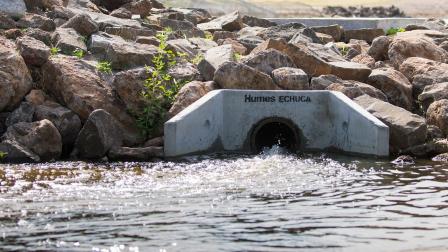Flood management in Melbourne is a shared responsibility between Melbourne Water, councils, emergency services and other key partners. We use multiple strategies to limit the impact of floods before they happen, and keep you safe when they do.
Roles and responsibilities with flooding – transcript (69KB, PDF)
Minimising flood risk
New drainage infrastructure isn’t always the best or most cost-effective way to reduce flood risk. It can be disruptive to build, and isn’t possible in some areas due to limited space. We carefully consider any new flood mitigation infrastructure to balance economic, environmental and social factors.
Drainage infrastructure
Drains, retarding basins and other infrastructure reduce flood risk near your home by keeping stormwater away.
- Melbourne Water builds and maintains major regional drains.
- Councils manage local drainage systems, including street gutters.
- Property owners are responsible for their own drains.
New housing and property development
Flood planning controls ensure new houses are built in safer locations, or are designed to better withstand floods.
- Melbourne Water sets building and renovation criteria and reviews planning permits.
- Councils administer and enforce local planning schemes.
Planning and preparedness
Flood modelling and mapping
Flood models and maps help everyone to understand their flood risk, so they can make informed decisions and plan for the future.
- Melbourne Water creates flood models for rivers, coastlines and major regional drains across Greater Melbourne.
- Melbourne Water works with councils to create flood models for local council drains.
Community education
Joint flood education programs ensure communities are aware of their risk and have the right information to prepare for floods.
- VICSES works with the community to prepare for emergencies and stay safe. VICSES also offers general flood and storm preparedness advice, and Local Flood Guides in many high-risk locations.
- Melbourne Water provides flood information that helps communities, councils and emergency services prepare for future floods.
- Councils coordinate local planning and recovery efforts for flood emergencies.
Response and recovery
Victoria State Emergency Service (VICSES) is the designated control agency for flooding in Victoria. They lead emergency preparation, evacuation support and rescue efforts if a flood occurs.
Flood warnings
Alerts give you time to prepare for floods or evacuate if needed.
- Melbourne Water monitors rainfall and water levels in rivers and creeks, and provides this data to the Bureau of Meteorology.
- The Bureau of Meteorology issues flood warnings.
- VICSES warns the community through VicEmergency app, website and hotline.
Supporting recovery
- Melbourne Water addresses impacts on Melbourne’s water, sewerage and regional drainage systems, as well as waterway health.
- Councils offer financial and practical help if your property is impacted.
You may also like...
Drainage system
Melbourne’s drainage system directs stormwater away from urban areas to reduce the risk of flooding, but extreme rainfall can still sometimes cause floods.

Flood modelling
Flood models identify which areas are most likely to flood, how quickly, and how deep the water may get.
Prepare for flooding
By understanding your flood risk and taking a few simple actions, you can be prepared for flooding.




